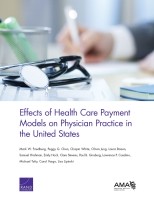| 来源类型 | Research Reports
|
| 规范类型 | 报告
|
| DOI | https://doi.org/10.7249/RR869
|
| ISBN | 9780833088949
|
| 来源ID | RR-869-AMA
|
| Effects of Health Care Payment Models on Physician Practice in the United States |
| Mark W. Friedberg; Peggy G. Chen; Chapin White; Olivia Jung; Laura Raaen; Samuel Hirshman; Emily Hoch; Clare Stevens; Paul B. Ginsburg; Lawrence P Casalino; et al.
|
| 发表日期 | 2015
|
| 出版年 | 2015
|
| 页码 | 142
|
| 语种 | 英语
|
| 结论 |
Payment Models Affect Practices - Multiple practice leaders and market interviewees reported that their own practices or others in their markets were changing their organizational models in response to new payment models.
- Respondents perceived that alternative payment models have encouraged the development of team approaches to care management.
- Market observers and physician practices reported that global capitation and related shared savings models were changing relationships between primary care and subspecialist physicians.
- Physician practices reported making significant investments in their data management capabilities to track and improve performance in alternative payment models.
- The multiplicity of pay-for-performance and other incentive programs has created a heavy administrative burden for some physician practices.
Payment Models Affect Physicians - The financial incentives applied to physician practices via alternative payment models were not simply "passed through" to individual physicians. Practice leaders described transforming certain practice-level financial incentives into internal nonfinancial incentives for individual physicians. Leaders acknowledged the presence of inconsistencies between financial and nonfinancial incentives. Alternative payment models had negligible effects on the aggregate income of individual physicians within the sample. Some physicians reported wanting to have their incomes more closely linked to quality and efficiency of care.
- Alternative payment models have not substantially changed how physicians delivered face-to-face patient care. Additional nonclinical work created significant discontent. Most physicians in practice leadership positions were optimistic and enthusiastic about alternative payment models, while most physicians not in leadership roles expressed at least some level of apprehension.
|
| 摘要 |
- To optimize the quantity and content of physician work under alternative payment models, ensure that physician practices have support and guidance.
- To improve the effectiveness of alternative payment models, address physicians' concerns about the operational details of these payment models.
- To help them succeed in alternative payment models, ensure that physician practices have data and resources for data management and analysis.
- To help physician practices respond constructively, harmonize key components of alternative payment models, especially performance measures.
|
| 主题 | Affordable Care Act
; Health Care Delivery Approaches
; Health Care Pay for Performance
; Health Care Reform
; Health Economics
; Health Information Technology
; United States
|
| URL | https://www.rand.org/pubs/research_reports/RR869.html
|
| 来源智库 | RAND Corporation (United States)
|
| 引用统计 |
|
| 资源类型 | 智库出版物
|
| 条目标识符 | http://119.78.100.153/handle/2XGU8XDN/108162
|
推荐引用方式
GB/T 7714 |
Mark W. Friedberg,Peggy G. Chen,Chapin White,et al. Effects of Health Care Payment Models on Physician Practice in the United States. 2015.
|
|
文件名:
|
x1539787735091.jpg
|
|
格式:
|
JPEG
|

|
文件名:
|
RAND_RR869.pdf
|
|
格式:
|
Adobe PDF
|
除非特别说明,本系统中所有内容都受版权保护,并保留所有权利。